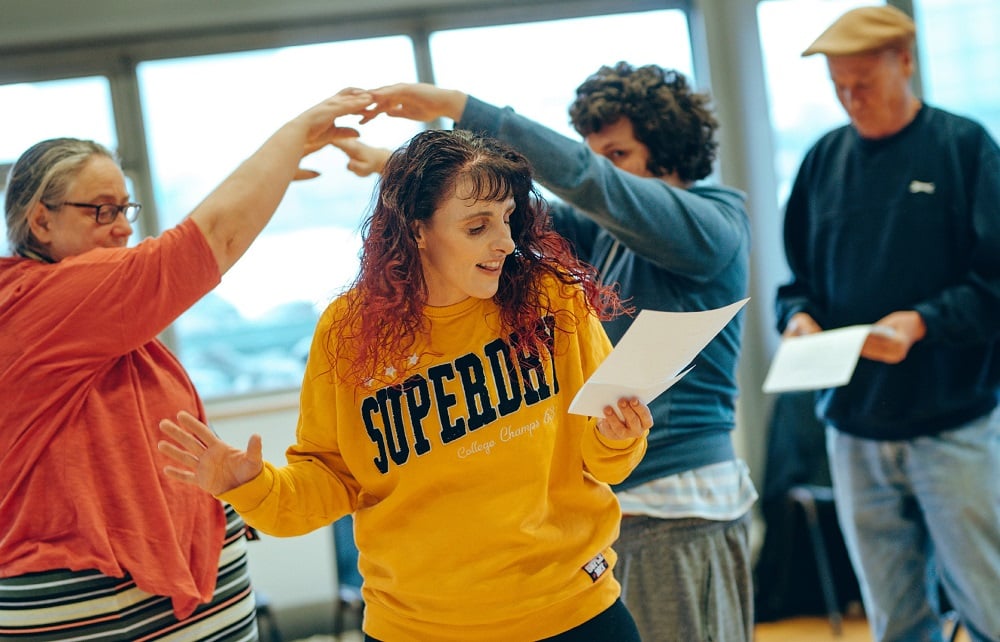
The 'Our Space' project
Photo: Dom Moore
How community engagement can change your life
We can only change our local communities if we’re willing to change ourselves, says Carol Jones.
The launch of Arts Council England’s 10-year strategy Let’s Create encouraged me to re-look at the term community engagement. What does it really mean, how has practice developed over the last ten years and where is it heading?
In his introduction to the strategy Arts Council England Chair Sir Nicholas Serota recalls the public artwork ‘we’re here because we’re here’, that created a living memorial to mark 100 years since the Battle of the Somme. He stresses the bold vision of its creators, artist Jeremy Deller and National Theatre director Rufus Norris, and puts this in the context of the collective creativity of the 1500 volunteers involved, and the project’s success in dissolving barriers between artists and audiences.
This public artwork, rightly described as monumental, wasn’t constrained by a ‘community engagement’ label – yet it made authentic, substantive connections with individuals and communities across the length and breadth of England. The volunteers weren’t seen as a collection of market segments to be targeted in an effort to extend reach; they were seen as indispensable partners in the creative process and in touching people’s lives.
Transformative engagement
Let’s look at a smaller-scale example that continues to develop community engagement into something vital and transformative. As part of the Behind the Scenes series on AMAculturehive, Theatre Royal Plymouth take us through their ‘Our Space’ project from three different perspectives: Engagement Manager, practitioner and participant.
In the first of three blogs, Sara Rhodes, the theatre’s Engagement Manager, tells us how the programme started, how it’s evolving to meet the needs of the community and the impact it’s having on both the participants and the theatre.
‘Our Space’ began life eleven years ago with a simple invitation to people who were sleeping rough outside the theatre and using drugs in the toilets to come in and have a chat over a hot drink. It has developed into a creative programme for adults with multiple and complex needs. Its members come from all walks of life and may have faced challenges involving homelessness, mental health issues, re-offending, substance misuse; or they may feel isolated for other reasons. The project continues to evolve and respond to the needs of the community.
It offers three levels of engagement: community hub drama workshops held in partnership with local services and organisations; weekly workshops in drama held at Theatre Royal Plymouth’s Production and Learning Centre; and Project X, a bespoke training programme for longer standing members to make work together and gain further skills that are transferable to everyday life.
Person-centred and co-created
The project has gone from strength to strength because it continues to be rooted in a person-centred and co-created approach that relies on building meaningful relationships with partners as well as participants. This way of working takes time. You need to gain trust and allow time for change to happen, and this journey is different for each person.
Over ten years, the programme worked with 41 partner services to provide 690 individuals with new opportunities. In April 2018 ‘Our Space’ became available as a social prescription through the Wolesley Trust, working with 28 primary care providers across Plymouth. Sara emphasises that the programme would not have been possible without building and maintaining strong partnerships with local organisations and services.
Socially engaged practice is at the heart of the work of the Engagement and Learning team at Theatre Royal Plymouth: they have become experts in working with multiple and complex needs. The coming years will be about sharing our learning and developing the project into a framework that could then potentially be used by others.
The most powerful advocates for the project are its participants themselves: one of them, Clive Rowe, Big Issue seller, member of Project X and the Our Space Steering Committee shares his experience in the third blog of the series. Sara says: “They have not only become part of our theatre community, but they are also our colleagues, artists on our stages, and our practitioners connecting local communities through the arts.”
For the community
Here we see a real recognition that communities do not exist to serve the arts; the arts exist to serve communities. It’s a great example of community engagement that creates change in the arts organisation – across its programming, processes, and way of thinking.
Why does this work? It’s rooted in learning about the needs and interest of the community. Only if an organisation is doing key things differently as a result of its engagement efforts is it truly focused on the community. If it’s not listening, learning and changing, it’s probably just focused on itself. But if it can build a genuine relationship where all participants are changed as a result of their creative contributions, it’s powerful, transformative, life-changing stuff.
You can find more examples of transformative engagement on AMAculturehive and many more as part of our global community engagement takeover across the next few weeks.
Carol Jones is Editor at AMAculturehive
culturehive.co.uk
a-m-a.co.uk
[email protected]
@Carol123Jones | @amadigital
This article, sponsored and contributed by AMAculturehive, is part of a series sharing resources and learning from the online library for the sector.
Join the Discussion
You must be logged in to post a comment.